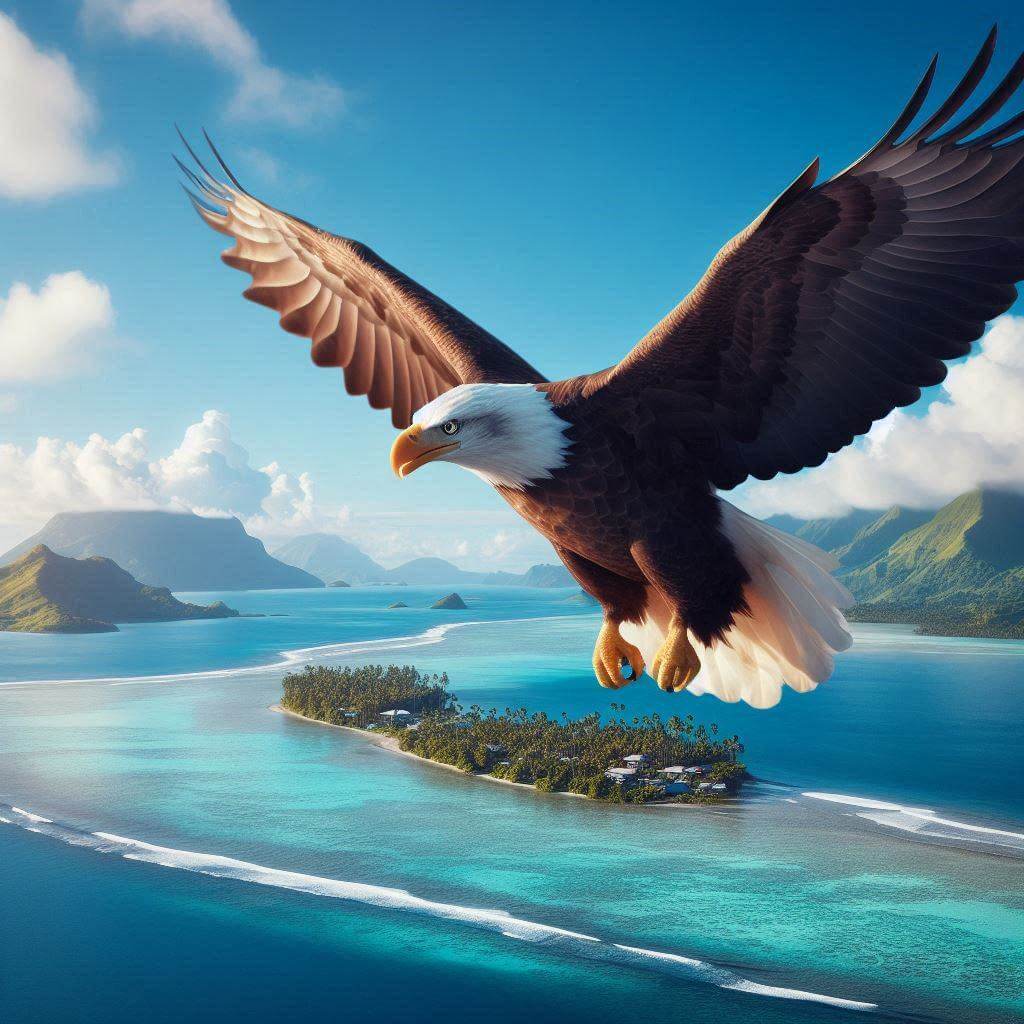The flag of American Samoa is a striking emblem that beautifully captures the territory's unique identity and its relationship with the United States. It features a white triangle bordered in red that points towards the fly side of the flag.
Set against a blue field, a majestic bald eagle takes center stage, clutching two traditional Samoan symbols in its talons: a war club known as fa'alaufa'i and a fly-whisk called fue. This intricate design seamlessly blends American and Samoan cultural elements, creating a powerful visual representation of the territory's heritage and status.
American Samoa information
| National Flag Day | April 17 |
| Sovereign state | — |
| Official name | American Samoa |
| Capital | Pago Pago |
| Population | 55,519 |
| Area | 199 km² |
| Currency | United States dollar (USD) |
| Language | English, Samoan |
| Continent | Oceania |
| Region | Pacific Islands |
| Subregion | Polynesia |
| Borders | — |
| Timezone | Samoan Time (SST) UTC-11 |
| Calling code | +1 684 |
| Top-level domain | .as |
History of the American Samoa Flag
The flag of American Samoa was officially adopted on April 27, 1960, marking a significant milestone in the territory's history. Its creation was part of a broader effort to establish a distinct identity for American Samoa while acknowledging its relationship with the United States. The flag's designer, Fareti Sotoa, drew inspiration from both American and Samoan cultures to create a unique and meaningful symbol. Prior to 1960, American Samoa had no official flag, and the U.S. flag was used for all official purposes. The adoption of this new flag provided American Samoans with a powerful symbol of their own, fostering a sense of pride and unity among the islanders.
Symbolism and Design of the American Samoa Flag
 Every element of the American Samoa flag is imbued with deep symbolism. The white triangle, pointing towards the fly, represents peace and purity. Its red border signifies courage and the sacrifices made by the Samoan people throughout their history. The blue field that dominates the flag reflects the vast Pacific Ocean surrounding the islands, as well as concepts of freedom and loyalty. The bald eagle, an iconic symbol of the United States, serves as a reminder of American Samoa's status as an unincorporated territory of the U.S. In its talons, the eagle grasps two traditional Samoan symbols: the war club (fa'alaufa'i) and the fly-whisk (fue). The fa'alaufa'i symbolizes the wisdom and strength of Samoan chiefs, while the fue represents their authority and power. This combination of American and Samoan symbols perfectly encapsulates the unique cultural blend that defines American Samoa.
Every element of the American Samoa flag is imbued with deep symbolism. The white triangle, pointing towards the fly, represents peace and purity. Its red border signifies courage and the sacrifices made by the Samoan people throughout their history. The blue field that dominates the flag reflects the vast Pacific Ocean surrounding the islands, as well as concepts of freedom and loyalty. The bald eagle, an iconic symbol of the United States, serves as a reminder of American Samoa's status as an unincorporated territory of the U.S. In its talons, the eagle grasps two traditional Samoan symbols: the war club (fa'alaufa'i) and the fly-whisk (fue). The fa'alaufa'i symbolizes the wisdom and strength of Samoan chiefs, while the fue represents their authority and power. This combination of American and Samoan symbols perfectly encapsulates the unique cultural blend that defines American Samoa.
Usage and Significance of the American Samoa Flag
 The flag of American Samoa plays a crucial role in the territory's civic and cultural life. It is prominently displayed on government buildings, schools, and public institutions across the islands. During national holidays, such as Flag Day (April 17) and Constitution Day (October 17), the flag takes center stage in celebrations, parades, and official ceremonies. It's also a source of pride for American Samoans participating in international events, such as the South Pacific Games or cultural festivals. The flag serves as a unifying symbol, reminding the people of their shared heritage and unique position as both Samoans and part of the American family. Its presence at official events and in everyday life reinforces the territory's identity and its special relationship with the United States.
The flag of American Samoa plays a crucial role in the territory's civic and cultural life. It is prominently displayed on government buildings, schools, and public institutions across the islands. During national holidays, such as Flag Day (April 17) and Constitution Day (October 17), the flag takes center stage in celebrations, parades, and official ceremonies. It's also a source of pride for American Samoans participating in international events, such as the South Pacific Games or cultural festivals. The flag serves as a unifying symbol, reminding the people of their shared heritage and unique position as both Samoans and part of the American family. Its presence at official events and in everyday life reinforces the territory's identity and its special relationship with the United States.
Interesting Facts About the American Samoa Flag
- The American Samoa flag is the only U.S. territorial flag to feature the bald eagle, making it unique among U.S. territories.
- The flag's design was chosen through a territorial flag design competition, with Fareti Sotoa's entry emerging as the winner.
- Despite being a U.S. territory, American Samoa maintains its own Olympic team and flies its territorial flag at the Olympic Games.
- The red, white, and blue colors of the flag not only echo the U.S. flag but also represent the traditional colors of Samoa.
- The flag is sometimes referred to as the "eagle flag" by locals due to its prominent eagle design.
- In Samoan culture, the fly-whisk (fue) is often used in traditional ceremonies and is considered a symbol of high rank and authority.